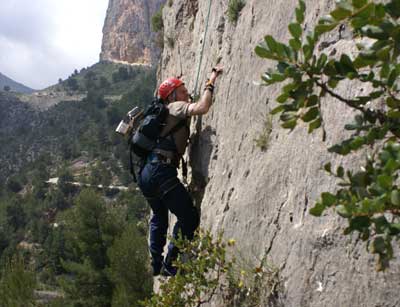Touchstone test piece - Research information - (archived research as it progressed)

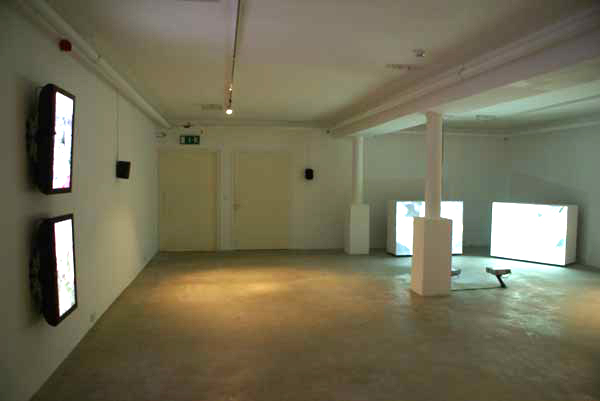
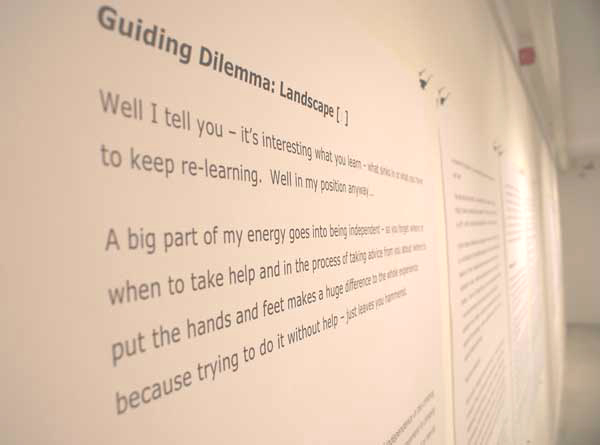
Click to:
Echo valley / A Guiding Dilemma (Exhibition images from the Munter Hitch Gtgallery)
Echo Valley / A Guiding Dilemma (Exhibition at Void gallery)
Echo Valley / A Guiding Dilemma (Press release)
Research information:
AHRC funded exploratory research with a blind person rock climbing. Developing new spatial narrative using collaborative and studio based processes and technology.
Introduction:
Most cultural forms of landscape representation prioritise sight. They define landscape through sight - through the lens of an eye or camera - it's what is seen and the interpretation of what is seen. How much of the landscape is experienced through sight? What is missed through this ocular prioritisation? What is the landscape experience without sight? How can we develop narratives which address other senses of being in the landscape.
Touchstone regularly takes a blind person climbing over a long period of time and asks how can we use that accumulated experiential activity to learn more or construct new models of our experience of landscape and our representations of that space?
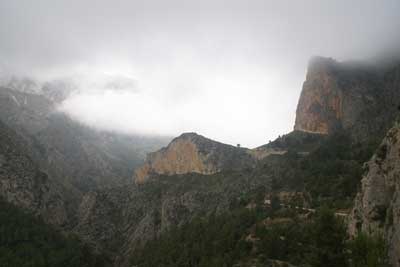
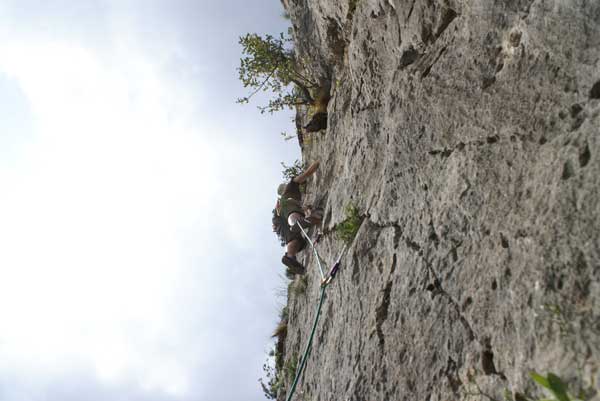
Does a blind climber experience the feeling of exposure? This project begins with the idea that the climbers' landscape is not predicated on the priority of sight but is predicated on a balance of senses. Climbing is a useful methodology because it expands the tactile and physical experience of landscape and because it embodies a level of problem solving and creativity.
The project: (initial propositional text)
The project will further my practice based approach to experiential landscape to produce new spatial narratives (landscape) stemming from a developmental process of working collaboratively one to one with John using technology, performance and studio based methodologies.
It will develop innovative video techniques incorporating multiple video lenses (mini lenses and systems already available for security systems) to develop "finger tip" video documentation of climbing based methodologies - visualising a tactile relationship between the body and it's environment which, combined with other research data such as dialogical audio,text and physical construction, might offer a more complex relational representation of place and being.
The project combines in-situ based research with studio based
in-situ - working outside on specific rock-climbs and in particular noted (within a climbing context) locations producing performative and documentary research incorporating and developing video/audio technologies to gather "finger tip" research material.
studio-based research - analytical research developing the in-situ methodologies - including the use of new technologies - and creative research proposing and prototyping outcomes. This will experiment with research materials gathered through in-situ research. It will explore the development and presentation of this material using audio and visual digital editing, reprographic production, textual/braille experimentation, physical construction and installation.
It is exploratory research working towards a variety of contemporary art-based outcomes (but developed to have relevance beyond) predicated on research into spatial engagement and experiential landscape and presenting new landscape artworks and alternative models of spatial narrative construction.
The project will produce outcomes which will have relevance across fields such as visual arts, geography studies, blind interest groups and outdoor sports/pursuits.
In progress: April 2007.
The project is now well under way and has several elements well developed.
John has been blind for 15 years since his sight deteriorated through disease. He is a physiotherapist and a keen outdoor person having done several treks for charity in places such as the Andes. The project began with John being a complete beginner as a climber.
As the project has developed it has become obvious that the project is not just about a blind subject but about John person who is blind so his personality and individual circumstances become crucial to the project which has a narrative of landscape at it's heart also hopes to articulate within this a complex narrative of people and the activity of climbing as an engagement with place.

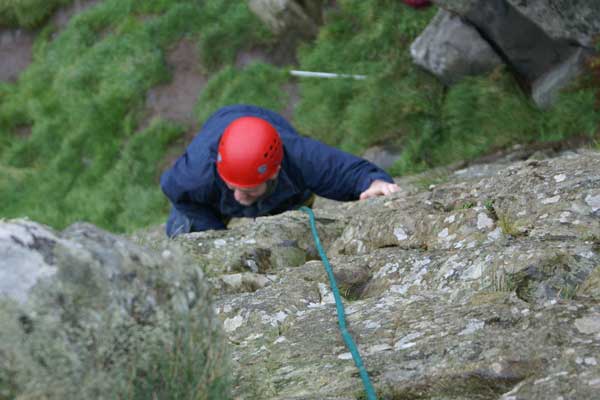
We have made climbing day trips to Donegal and a longer trip to Costa Blanca, Spain where there is very good and warmer climbing. The actual places have become very important the geography and our interaction with the place contributes strongly to the sense of experience from the physical aspects such as weather and the type height and texture of rock to the location which might determine ambient sounds, different languages, smells, food types and other contextual aspects.
After the first stage of the project John has developed confidence and skills through regular climbing session and is now able to climb at a low but reasonable level indoors and out. He can also belay a climbing partner (myself) - so a level of trust and understanding has developed. These aspects and developments have been documented though video and photography with the project including circumstantial and conversational material.
I'm developing and experimenting with various formats of video and audio technology -fabricating video and audio equipment which strap onto fingers, wrists and ankles in order to record specific aspects of this activity.



We now have a lightweight system where John can wear tiny adapted cameras on his fingers and climbing shoes as well as higher grade cameras attached to his backpack. In total we have eight unobtrusive onboard cameras recording his climbing activity. This equipment is being tested and used in a variety of locations.
Interesting material deriving from the direct research methodologies are key but other material is able to contribute and humanize the project.
Here are some examples of both these elements:
The walk into places is slow and tedious sometimes tricky with boulders and blocks to negotiate so when we arrive and get to climbing it's much more enjoyable because I'm not relying on someone to physically guide me and I feel much freer to determine my own way.


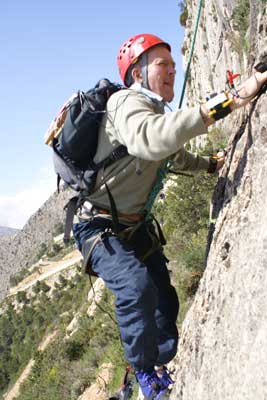
John commenting that climbing enables him a greater sense of independence (e.g. than hiking) because he is able to feel ahead and determine his movements without instruction or guidance by others.

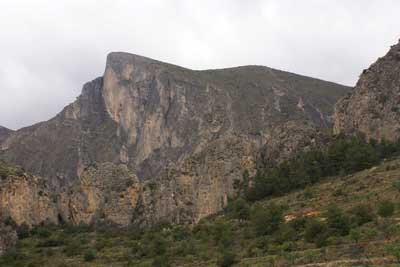
It's pointless to describe a scene to me because it's meaningless I kind of don't want to know that it's a beautiful view unless there's some information in it which is relative or interpretive to what I can experience or what might add to my decision making then it's not worth telling me what we could see for pleasure. John talking about commentary on the views.
How the specific geographical logic of Derry (John's home town which is a walled, military city on a slope) has allowed a good level independence due to the possibility of learning and becoming familiar with the layout of the city.
Discussion about how the process of becoming a blind tended to decrease his range of range physical movements such as shorter steps and defensive arm positions and climbing enforces a greater reaching. As a physiotherapist John felt the muscles and tendons make the new actions and seemed to unravel and extend. It was an enjoyable feeling -the body feeding back information about the activity as a pleasure.
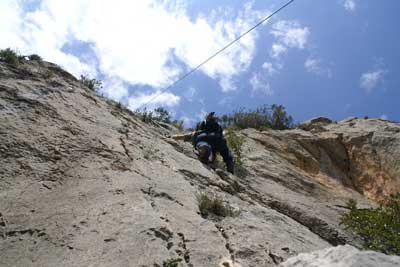
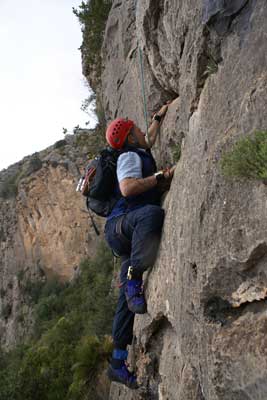
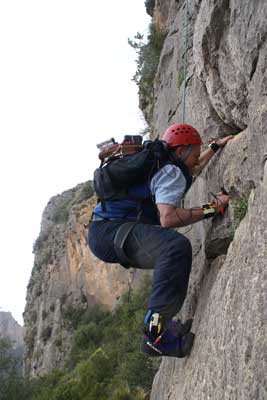
There's two parrots on a perch. One says to the other, "can you smell fish?"...
We discussed how as a blind person climbing John has to make best use out of climbing holds he has located whereas a sighted person may seek alternative holds. This in some ways is like climbing at a harder level because many the holds are eliminated because they are not found. So a grade S (sport grade 3 ish) might actually be climbed as a VS (sport grade 4+ ish) or higher.
Early on I gave a training session which was about stepping high with your feet as a way of reaching hand holds which were out of reach. This is key to solving many climbing moves and obviously relies to a large extent on seeing ahead because you can't reach ahead. So this became our leap of faith and is the key and often crucial aspect of harder climbs for John. However using creativity, balance and composure reduces the leap to something more controlled and feel less reckless*. Exploring all the rock intimately often reveals new solutions which maximize the potential of finding holds above. For example, imagining how such a crack or feature continues reading the rock formation based on what went below or on other climbs of the same rock type.
Sometimes verbal instruction is necessary and this forms an interesting part of the process.
During the sessions where I have been climbing blind folded and John has been belaying it's been interesting and necessary to explore a greater reliance on touch and balance and our discussion and communication has to be harnessed to sequences within and between movement and topography how do you relate ones position with another's without visual reference points?
The verbal descriptions of holds is interesting and important e.g. one finger, two finger, sloper, jug, shelf, ledge, crimp, pinch, spike, groove, hollow, scoop, notch, rib, finger crack, fist crack, horizontal, vertical, diagonal
And also of moves bridge, layback, step up, side pull, pull up, side on, smear, edge, dink, hop swap, reach, jam, mantel
All of which are common to the language of climbing and its particular landscape.
The 5 day trip to Spain was a broad experience but having the climbing as the focus of each day made it really engaging. You felt that you had a purpose in the place.
John's comments about the trip to Spain.
Since April 2007 the process continued and dialogue developed aroun the project culminationg in a series of new works and exhibitions:
Links to:
Echo Valley / A Guiding Dilemma (Exhibition at Void gallery)
Echo Valley / A Guiding Dilemma (Press release)
* all Johns climbing was done in a safe manner but none the less the climbing was chosen to be challenging and of an often exposed nature.
Funded by the AHRC Landscape and Environment programme and supported by the University of Ulster School of Art and Design Research Institute.
AHRC website http://www.landscape.ac.uk/
